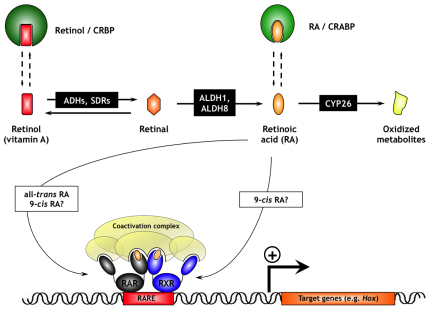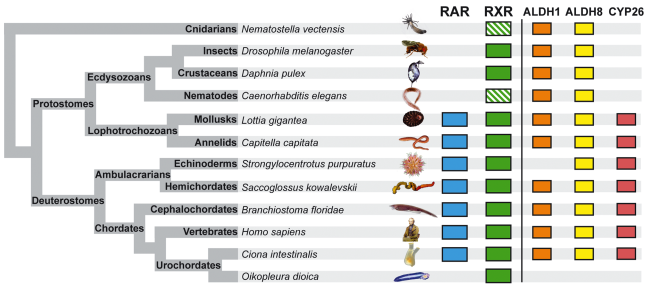Vitamin A (retinol) is a fat-soluble morphogen essential for the maintenance of various tissues and organs. Vitamin A and its derivatives, collectively referred to as retinoids, are also crucial for the promotion of vision, for immune and reproductive functions as well as for embryonic development.
In vertebrates, the vitamin A-derived morphogen retinoic acid (RA) is the main mediator of retinoid-dependent intercellular signaling, a molecular process that is generally referred to as the RA signaling cascade or the RA pathway. Within a cell, RA is synthesized, in the cytoplasm, from vitamin A (retinol) in two steps, the second being the irreversible oxidation of retinal to RA by RALDH enzymes of the ALDH1 or ALDH8 families. The bioavailability of endogenous RA is further controlled through its degradation by CYP26 enzymes. Most biological functions of RA are mediated by the binding of RA, in the nucleus, to heterodimers of two nuclear hormone receptors: the retinoic acid receptor (RAR) and the retinoid X receptor (RXR).

The RA signaling cascade was long thought to be vertebrate-specific, but studies of our team and others in invertebrate chordates have revealed roles for retinoids that are conserved in all chordates. These studies have also established that, of all invertebrates, only amphioxus has a vertebrate-like retinoid signaling system, both in terms of molecular composition and of biological functions, with the important added value of a lack of significant genetic redundancy.

Outside the chordate lineage, however, evidence for functional roles of retinoids and of the RAR/RXR heterodimer remains scarce. Although we have been able to identify genes encoding orthologs of vertebrate RALDH and CYP26 as well as of vertebrate RAR and RXR in ambulacrarian deuterostomes (such as hemichordates and echinoderms) and lophotrochozoan protostomes (such as annelids and mollusks), extensive experimental evidence for retinoid and/or RAR/RXR functions in these animal lineages is still lacking. Previous analyses based on pharmacological treatments have nonetheless suggested that retinoids may have distinct effects during echinoderm, annelid, and mollusk embryogenesis. Moreover, retinoids have also been implicated in tissue regeneration of insects and crustaceans and in cell proliferation and neuronal differentiation of cnidarians, all of which are animals, whose genomes do not encode a RAR. Collectively, these data hence suggest that functions for retinoids as morphogens originated before a functional RAR/RXR heterodimer and, given the importance of the RAR/RXR heterodimer for mediating retinoid signaling in chordates, evoke the question of the evolutionary origins of the ligand binding capacities of RAR and RXR.
Using a combination of molecular, developmental, and genomic approaches, in the EvoInSiDe team, we are thus currently characterizing the functions of retinoids and of RAR and RXR in various animal lineages, including lophotrochozoans, ambulacrarians, invertebrate chordates, and vertebrates. Comparisons of these respective functions will reveal roles for retinoids that are dependent on RAR and RXR and those that are independent of the receptors. Moreover, cross-comparisons of these results between the different species will identify conserved and divergent elements of retinoid signaling, which in turn will allow the reconstruction of the evolutionary diversification of this morphogen-dependent signaling cascade in bilaterian animals.

Laboratoire de Biologie du développement UMR 7009
Cette UE se déroule sur 2 semaines et a lieu au laboratoire de Biologie du Développement de Villefranche -sur-Mer (LBDV). Elle inclut l’examen de l’UE d’analyse scientifique (5V089) suivie par les étudiants de la spécialité de Biologie du Développement.
Durant la 1ère semaine, les étudiants participent à des ateliers et des rencontres avec les chercheurs du laboratoire.
Durant la 2ème semaine, les étudiants sont répartis dans les équipes pour y réaliser un mini projet qu’ils présentent le dernier jour du cours. Le cours est donné en anglais pour tout ou partie.
Modalités d’évaluation
Présentation orale du mini-projet (binôme, 100 %)
UE en anglais (partiellement ou totalement)
Master BMC, S3, 6 ECTS
Code UE: 5V200
Responsable de l’UE: Carine BARREAU (MCU): carine.barreau [at] obs-vlfr.fr
Cette UE permet aux étudiants de 1ère année de Master de passer 2 semaines à l’Observatoire Océanologique de Villefranche-sur-Mer. Le cours est obligatoire pour les étudiants du Master Biologie Intégrative, parcours Biologie et Bioressources Marines (BBMA) tandis qu’il peut être choisi en option par les étudiants du Master Biologie Moléculaire et Cellulaire (BMC). Les étudiants participent à des ateliers de présentation des organismes marins utilisés par les équipes de recherche du laboratoire (LBDV) et apprennent à les manipuler au cours de travaux pratiques dont les thématiques vont de la Biologie du Développement fondamentale à la toxicologie appliquée.
Modalités d’évaluation
Analyse d’article et présentation orale (50%)
Compte-rendu écrit de TP (50%)
UE partiellement en anglais
Master BIP, S2, 6 ECTS
Code UE: 4B022 (ouverte au Master BMC)
Responsable de l’UE: Carine BARREAU (MCU): carine.barreau [at] obs-vlfr.fr
Cette UE complémentaire se déroule sur 2 semaines et permet aux étudiants de découvrir les différents aspects (métiers & recherche) de l’Observatoire Océanologique de Villefranche-sur-Mer (OOV). Ateliers et journal clubs sont organisés afin que les étudiants mettent en pratique leurs connaissances théoriques en biologie et développent leur capacité de communication scientifique en français et en anglais.